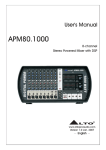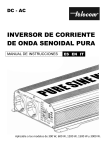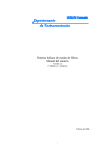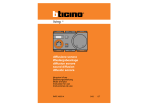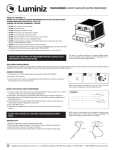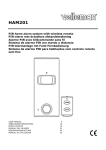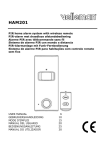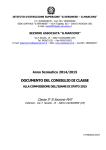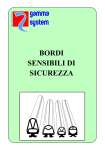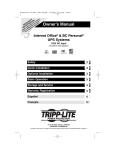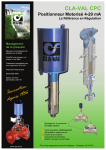Download BXM12/30-U BXM12/30-B BXM12/50-U BXM12/50-B
Transcript
® BXM12/30-U BXM12/50-U * BXM12/30-B BXM12/50-B * * STAZIONE DI ALIMENTAZIONE POWER SUPPLY STATION COFFRET CHARGEUR SUPERVISÉ ENGLISH ITALIANO FRANÇAIS DESCRIZIONE GENERALE DESCRIPTION CARACTÉRISTIQUE GÉNÉRALE BXM12/30-U, BXM12/50-U, BXM12/30-B e BXM12/50-B sono Stazioni di Alimentazione studiate per l'integrazione della corrente fornita dalle centrali antifurto in impianti particolarmente esigenti. I vari modelli sono costituiti da un Modulo Alimentatore e da un'Elettronica di Controllo alloggiati in un contenitore metallico. Il Modulo Alimentatore fornisce la tensione continua a partire dalla tensione di rete. Il contenitore è protetto contro i tentativi di sabotaggio ed è in grado di alloggiare un Accumulatore che garantisce l'alimentazione in caso di black-out (mancanza della tensione d'ingresso). Caratteristiche: BXM12/30-U e BXM12/50-U: 10 LED di segnalazione (rete, guasto, uscita 1, uscita 2, uscita 3, guasto caricabatteria, switching disconnesso, batteria assente, batteria bassa, batteria disconnessa); 2 uscite open-collector (rete e guasto); Morsetti anti-sabotaggio; Caratteristiche: BXM12/30-B e BXM12/50-B: Interfaccia bus BPI; il bus BPI IN (collegato alla centrale) è completamente disaccoppiato dal bus BPI OUT(i Bus sono galvanicamente isolati); le risposte del bus BPI OUT (locale) vengono riportate verso la centrale sul BPI IN. 2 LED di segnalazione (rete e guasto); Possono essere connessi fino ad 8 BXM12-B sul bus BPI. L'indirizzo viene impostato tramite i microinterruttori 25 (il dip switch marcato con "1" viene ignorato). The BXM12/30-U BXM12/50-U, BXM12/30-B, BXM12/50-U Power Supply Stations have been especially designed to satisfy the backup power needs of particularly demanding Burglar control systems. All models have a PCB and a Power Supply Module located inside a metal box. The Power Supply Module supplies continuous voltage from the Mains. The tamper protected box can house a standby Battery for power in the event of black-out (input voltage failure). BXM12/30-U, BXM12/50-U Features 10 Warning LEDs (Mains, Trouble, Output 1, Output 2, Output 3, Battery Charger Trouble, Switching Power Supply Disconnected, No Battery, Low Battery, Battery Disconnected. 2 Open-collector Outputs (Mains and Trouble) Tamper Microswitches BXM12/30-B, BXM12/50-B Features BPI Bus Interface: the Control panel BPI IN Bus is totally uncoupled from the BPI OUT Bus (electrically isolate). The result of BPI OUT Bus polling is sent to the Control panel via the BPI-IN Bus. 2 warning LEDs (Mains and Trouble) Up to 8 BXM12-B version can be connected to the BPI Bus. The Addresses can be assigned via the DIP Switches 25 (DIP Switch 1 has no effect). Les alimentations en coffret BXM12-U et BXM12-B ont été spécialement développées pour les systèmes intrusion nécessitant un maintien de l’alimentation lors de la coupure du secteur. Les 2 alimentations sont composées d’un module de contrôle et de câblage, ainsi que d’une carte d’alimentation. La carte d’alimentation peut auto-rectifier la tension d’alimentation en réduisant celle-ci lorsqu’elle est trop élevée. Le coffret est autoprotégé, et peut recevoir une batterie de 17Ah 12V. Caractéristique BXM12/30-U et BXM12/50-U 10 LEDs de défauts (Défaut Secteur, Sortie 1, Sortie 2, Sortie 3, Charge Batterie, Carte Alimentation déconnectée, Absence Batterie, Batterie Basse, Batterie Déconnectée. 2 Sortie Collecteur-Ouvert (Secteur et Défaut) Contact d’Autoprotection Caractéristique BXM12/30-B et BXM12/50-B Bus BPI: le Bus BPI IN de la centrale est totalement isolé du Bus BPI OUT (isolement galvanique). 2 Sortie Collecteur-Ouvert (Secteur et Défaut) Jusqu’à 8 BXM12-B peuvent être connectée sur le BPI Bus. L’adressage est effectué via des DIP Switches 25 (DIP Switch 1 n’a pas d’effet). INSTALLAZIONE Locate the Power Supply Station as near as possible to the devices it must supply, this will reduce the voltage drop on the connections to a minimum. Choose the place of installation, and lay the cables. Drill the holes for the Power Supply Station and snatch bracket (7). Check for water pipes and wiring before drilling. Pull the wires through the wire entry (6). Using the screw locations (1), mount the Power Supply Station then attach the snatch bracket (7). Do not to over tighten the screw as this may damage the bracket. If you are connecting the Power Station to the BPI bus: use the DIP switches (25) to assign its Address. Complete the connections on the terminal board 23. Do not connect the input voltage (230 V) at this point. The Mains wires should be bunched and stripped but not soldered. Using the terminal board (15), connect the input voltage (230V ~+/ -10% 50/60Hz) to the Power Supply Module. IMPORTANT In order to comply with safety regulations, the Line must be connected La Stazione di Alimentazione deve essere installata il più vicino possibile alle apparecchiature che deve alimentare, in modo da ridurre al minimo le cadute di tensione sui collegamenti. Scelto il punto in cui installare la Stazione di Alimentazione, posare tutti i cavi necessari. Praticare i fori per il fissaggio della Stazione di Alimentazione e quello per il fissaggio del tassello antistrappo (7), facendo attenzione alle condutture idrauliche e ai fili della corrente. Passare i cavi per i collegamenti attraverso l'apertura 6, quindi fissare la Stazione di Alimentazione tramite i fori 1 e il tassello antistrappo 7, senza serrare troppo la vite per non rompere le alette di battuta. Se la Stazione di alimentazione deve essere collegata al bus BPI, impostare il suo indirizzo tramite i microinterruttori 25: Effettuare i collegamenti sulla morsettiera 23: per il momento non collegare la tensione di ingresso (230V). I fili della rete devono essere uniti tra loro con una fascetta e NON devono essere stagnati. Collegare la tensione di ingresso (230V~+/-10% 50/60Hz) alla morsettiera 15 del Modulo Alimentatore. ATTENZIONE Per un'installazione a norme, la Fase deve essere collegata al morsetto [L] e il morsetto [ ] deve essere collegato alla Terra. Inoltre, deve essere previsto un idoneo dispositivo di sezionamento e di protezione dell'alimentazione di rete nell'impianto elettrico dell'edificio, in accordo alle norme vigenti (legge 46/90): per esempio, un interruttore magneto-termico bipolare. Sistemare l'accumulatore nell'apposito spazio, quindi collegarlo all'Elettronica di Controllo tramite i connettori 5. Per collegare la batteria da 17 Ah sostiture i connettori 5 con dei capicorda ad occhiello che vanno fissati alla batteria con una vite ed un dado. Fare attenzione a non invertire le polarità dei collegamenti; se ciò si dovesse verificare, sostituire il fusibile 19 (T8A250V) DESCRIZIONE DEI MORSETTI Uscite di alimentazione protette da fusibile autoripristinante. Morsetti di massa. Uscita antisabotaggio Normalmente Chiusa: si apre quando si rimuove il pannello frontale della Stazione di Alimentazione oppure quando quest'ultima viene strappata dal muro. Uscita Open Collector Normalmente Appesa di Guasto Rete: si collega alla massa quando si accende la spia ~. Uscita Open Collector Normalmente Appesa di Guasto Generico: si collega alla massa quando si accende la spia G . Bus BPl OUT per il collegamento con altri dispositivi BPI. 1[O1] 3[O2] 5[O3] 2-4-6-11 [-] INSTALLATION to terminal [L] and the Earth to terminal [ ], and an bipolar isolating device (e.g. an automatic isolating switch) must be connected to protect against overvoltage and short-circuit . Locate the battery then, using the connectors (5), connect it to the PCB. When connecting a 17 Ah battery, use eyelet terminals instead of the connectors (5). The eyelet terminals must be secured by means of a screw and nut. Ensure the connection polarity is correct. In the event of unintentional inversion, change the fuse 19 (T8A250V). INSTALLATION Installer l’alimentation au plus proche des sytèmes à l’alimenter, ceci à fin de limiter au maximun les pertes en ligne. Choisir un lieu et amener les câbles nécessaire Percer les tous de fixation du boîtier et du support d’autoprotection (7). Contrôler la position des canalisations d’eau et les câbles existant avant de percer. Passer les câbles par le trou (6). Fixer le boîtier et le support d’autoprotection (7), prendre gare de ne pas endommager les câbles avec les vis. Si vous connectez la Station d’alim au bus BPI: utilisé les DIP switches (25) pour adresser. Completez les connexions sur le bornier 23. Ne pas connecter le secteur (230 V) à ce stade. Utiliser le bornier (15), pour connecter le secteur (230V ~+/-10% 50/60Hz) à la carte d’alimentation. IMPORTANT La connexion doit être conforme à la réglementation, la phase doit être connecté [L] et la terre sur [ ], ainsi qu’une protection électrique adaptée et conforme. Installer la batterie et connectez la (5). Lorsque vous connectez une batterie 17 Ah, modifier les oeillets (5). Dans ce cas, des écrous seront utilisés pour sécuriser le montage . Assurez vous de la polarité de la batterie. En cas d’inversion changer le fusible 19 (T8A250V). v(V) i(A) TERMINAL DESCRIPTION DESCRIPTION DES BORNES - (1) Supply outputs protected by automatic restoral fusee Sortie protégée par fusible réarmable 0 - Ground terminals Borne de terre (0V) Sortie Normalement fermé: ouvert lorsque le boîtier est ouvert ou si il n'est plus connecté au mur. 7-8[AS] - - Normally Closed Tamper output: opens when the front panel of the Power Supply Station is removed, or when the Power Supply Station is snatched from the wall. 9 [RETE] 0 0,1 Normally Open repeat output for Mains Trouble: connects to negative when the LED ~turns ON. Sortie normalement ouverte copie des Défauts: connecté au négatif lorsque la LED ~est à ON. 10 [G] 0 0,1 Normally Open repeat output for Power-Supply Cutout Module: connects to negative when the Sortie normalement ouverte copie de la coupure carte alim: - - BPI OUT Bus (for BPI devices) Bus BPI OUT (vers périphérique BPI) - - BPI IN Bus (to be connected to the control panel) Bus BPI IN (vers centrale KYO) 12-13-14-15 [+][C][R][-] 16-17-18-19 Bus BPI IN per il collegamento con la centrale. [+][C][R][-] (1) Da ogni uscita è possibile assorbire al massimo 1,8 A però la somma delle correnti assorbite dai morsetti 1[O1], 3[O2] e 5[O3] non deve essere superiore alla Corrente Massima Erogabile dalla Stazione di Alimentazione (v. "CARATTERISTICHE TECNICHE").. LED G turns ON. (1) Each output provides a maximum current draw of 1.8 A, however, the total current draw of terminals 1[O1], 3[O2] and 5[O3] must not exceed the maximum current supplied by the Power Supply Station (refer to "TECHNICAL FEATURES").. connecté au négatif lorsque la LED G est à ON. (1) Chaque sortie peut débiter jusqu'à 1.8 A, cependant le courant total des sorties 1[O1], 3[O2] et 5[O3] ne doit pas dépasser le courant disponible sur la station d'alimentation (se referer à "CARACTERISTIQUES TECHNIQUES"). Fig. 2 -Parti della stazione di alimentazione-Power supply Components- Identification 19 20 21 22 23 24 25 26 27 28 SW 29 30 12 V OU T 5V SW NT C 12V ON OUT 5V NTC LB105- P 1 2 3 4 ON 1 1 LB105-P 1 2 3 4 SW 1 12V 12 V 5V 5V 2 IN 5V 5V IN 1 O1 2 3 O2 4 5 6 O3 7 8 AS 9 RETE 10 G 11 12 13 14 C R BPI OUT 15 16 17 + 18 19 C R BPI IN 8 1 2 O1 3 O2 (b) 7 4 5 O3 6 8 7 AS 9 10 RETE G 11 23b 12 13 14 15 C R BP I O UT 16 + 17 18 C R BP I IN 19 23a 3 14 6 15 16 18 17 (a) 4a 5 9 4b 13 1 12 1 11 10 CARATTERISTICHE TECNICHE TECHNICAL FEATURES BXM12 Modello /30-U /50-U /30-B Tensione di ingresso. /50-B 230 V ~ ÷10% 50/60 Hz 0,9 A Corrente assorbita (max.). 0,5 A 0,9 A 0,5 A Tensione di uscita max (prima di 14,7 V _ +/-1% sgancio sicurezza) . Tensione di uscita min (a batteria scarica) 10,2 V _ +/-1% 13,8 V Tensione nominale fornita Corrente nominale 3,0 A 5,0 A 3,0 A Temperatura di funzionamento Classe di isolamento Dimensioni (L x H x P) Peso (con accumulatori da 17 Ah) Livello di prestazione (CEI 79-2) Model Modèle Input voltage Tension Secteur Maximum current draw Consommation Max Output voltage Tension de Sortie Minimum output voltage Tension Mini de Sortie Nominal voltage 5,0 A Massima corrente permanente 2,4 A 4,0 A 2,4 A 4,0 A erogabile 1.8 A Massima corrente su [+] BPI OUT Tempo di ricarica (fino all'80% della 24 h batteria) 12 V - 17 Ah YUASA Batterie allocabiliMarcaModello(*) O NP 17-12 FR (*) equivalenti con classe d'infiammabilità o/or12 V - 7 Ah dell'involucro UL94-V2 o migliore YUASA NP 7-12 FR (*) Soglia di Sconnesione Modulo 14,7 V Alimentatore 11,0 V Soglia di segnalazione Batteria Bassa Soglia di Sconnessione Accumulatore CARACTERISTIQUES TECHNIQUE BXM12 10,2 V 5÷40 °C I 240 x 348 x 97 mm Nominal current supplied Courant Nominal Maximum current supplied Courant Maximum Maximum current supplied on output Courant Maximum par sortie Temps de Recharge (jusqu'à 80% de la capacité batterie) Recharge Time (up to 80% capacity) Battery compartmentMakeModel(*) An equivalent with a case flame class of UL94-V2 or higher Compartiment batterie (*) ou équivalent conforme à UL94-V2 ou supérieur Power Module Shutdown Threshold Seuil de coupure de l'alimentation Low Battery Signal Threshold Seuil de signalement Batterie basse Battery Shutdown Threshold Seuil de coupure Batterie Basse Operating temperature Température de fonctionnement Insulation level Classe d'isolation Dimensions (W x H x D) Dimensions (L x H x E) 8,6 Kg Weight (with 17 Ah battery) Poids (avec batterie 17 Ah) II Security grading (CEI 79-2) Grade de sécurité (CEI 79-2) PAR TS ID E N T IF IC A T IO N ID E N T IF IC A T IO N D E S P A R T IE S 1 4 wa l l -m o u n t s c r e w l o c a ti o n s (Ø 4 m m ) 4 tro u s d e fi x a ti o n a u m u r ( Ø 4 mm) 2 PCB C a rte d e g e s ti o n D e v i a to r e a n ti s tra p p o . A l l o g g i a m e n to p e r u n a c c u m u l a to r e d a 1 2 V , 1 7 A h (a ) o p p u r e d a 1 2 V , 7 A h (b ). C o n n e tto ri p e r l 'a c c u m u l a to r e . 3 S n a tc h m i c ro s wi tc h M i c ro s wi tc h d 'A P 4 1 2 V , 1 7 A h (a ) o r 1 2 V , 7 A h (b ) b a tte r y h o u s i n g L o g e m e n t B a tte ri e 1 2 V , 1 7 A h (a ) o u 1 2 V , 7 A h ( b ) 5 B a tte ry c o n n e c to rs C o n n e c te u r s B a tte r i e F o ro p e r il p a s s a g g io d e i c a v i. 6 W i re e n try E n tré e p a s s a g e d e c â b l e ID E N T IF IC A Z IO N E P A R T I F o r i (4 ) p e r i l fi s s a g g i o d e l l a S ta zi o n e d i A l i m e n ta zi o n e (Ø 4 m m ). E l e ttro n i c a d i C o n tr o l l o . P. T a s s e l l o a n ti s tra p p o . 7 S n a tc h b ra c k e t S u p p o rt d 'A P M o d u l o A l i m e n ta to r e S o n d a te rm i c a K S T p e r l 'o tti m i zza zi o n e d e l l a ri c a ri c a d e l l a b a tte r i a . (O p zi o n a l e ) V . m a n u a l e s p e c i fi c o . L e d d i s e g n a l a zi o n e d e l l a p re s e n za d e l l a te n s i o n e d i u s c i ta d e l M o d u l o A l i m e n ta to r e 8 P o we r S u p p l y M o d u l e K S T T h e rm a l p ro b e (a c c e s s o ry i te m ) fo r o p ti m i za ti o n o f th e b a tte ry c h a r g e p ro c e s s C a rte d 'a l i m e n ta ti o n 9 S o n d e th e r m i q u e K S T (a c c e s s o i r e ) p o u r o p ti m i s e r l a c h a r g e b a tte r i e 10 P o we r M o d u l e o u tp u t v o l ta g e LED L E D s e c te u r d e l a c a r te d 'a l i m e n ta ti o n 11 C o n n e c to r to b e u s e d fo r th e c o n n e c ti o n o f th e P o we r S u p p l y M o d u l e to th e o n b o a r d o u tp u t v o l ta g e c o n tr o l c irc u it C o n n e c te u r Å u ti l i s é p o u r i n te r c o n n e c te r l a c a r te a l i m e n ta ti o n e t l a c a rte d e g e s ti o n p o u r l a ré g u l a ti o n 12 P o we r S u p p l y o u tp u t v o l ta g e tr i m m e r (D O N O T A D J U S T ) 13 A u x i l i a r y o u tp u t C o n n e tto re p e r i l c o l l e g a m e n to d e l M o d u l o A l i m e n ta to r e a l l 'E l e ttro n i c a d i C o n tr o l l o . 14 C o n n e c to r to b e u s e d fo r th e c o n n e c ti o n o f th e P o we r S u p p l y M o d u l e to th e P C B M o rs e tti e ra p e r i l c o l l e g a m e n to d e l l a T e n s i o n e d i In g r e s s o (2 3 0 V ~ , 5 0 H z). 15 V i te d a r i m u o v e re p e r a p r i r e i l M o d u l o A l i m e n ta to r e . 16 F u s i b i l e d i p r o te zi o n e d e l M o d u l o A l i m e n ta to r e 17 C h i o d i n o d a ri m u o v e re p e r a p r i re i l M o d u l o A l i m e n ta to r e . 18 F u s i b i l e (T 8 A 2 5 0 V ) c o n tro l 'i n v e rs i o n e a c c i d e n ta l e d e l l e p o l a ri tà d e l l 'a c c u m u l a to re 19 C o n n e tto re p e r i l c o l l e g a m e n to d e l M o d u l o A l i m e n ta to r e 20 C o n n e tto re p e r i l c o l l e g a m e n to a l c i r c u i to d i c o n tr o l l o te n s i o n e d i u s c i ta 21 C o n n e tto re s u l m o d u l o d i a l i m e n ta zi o n e p e r i l c o l l e g a m e n to a l c i rc u i to d i c o n tro l l o te n s i o n e d i u s c i ta , p o s to s u l l a s c h e d a . T r i m m e r d i re g o l a zi o n e fi n e d e l l a te n s i o n e d i u s c i ta (N O N M O D IF IC A R E ). U s c i ta a u s i l i a r i a . C o n n e tto re p e r i l c o l l e g a m e n to d e l l a s o n d a te rm i c a M o rs e tti e ra p e r i c o l l e g a m e n ti (E n tr a m b e l e v e rs i o n i ). 22 23 M o rs e tti a n ti s a b o ta g g i o e u s c i te O p e n C o l l e c to r (s o l o v e r s i o n e - U ) 23a M o rs e tti B P I (s o l o v e r s i o n e -B ) 23b 24 Trim m e r d e ré g la g e d e la te n s i o n d e s o r ti e ( N E P A S M O D IF IE R S o r ti e A u x i l i a i re C o n n e c te u r Å u ti l i s é p o u r i n te r c o n n e c te r l a c a r te a l i m e n ta ti o n e t l a c a rte d e g e s ti o n p o u r l a p u i s s a n c e T e r m i n a l b o a r d fo r th e i n p u t B o rn e s d e c o n n e x io n d u v o l ta g e c o n n e c ti o n ( 2 3 0 V ~ , s e c te u r (2 3 0 V ~ , 5 0 H z) 5 0 H z) S c r e ws (to b e r e m o v e d wh e n th e P o we r S u p p l y M o d u l e i s V i s d e fi x a ti o n opened) F u s i b l e d e l a c a rte P o we r S u p p l y M o d u l e fu s e a l i m e n ta ti o n P i n ( to b e re m o v e d wh e n th e P i n ( p e r m e t l e d é m o n ta g e d e P o we r S u p p l y M o d u l e i s l a g ri l l e ) opened) F u s ib le (T 8 A 2 5 0 V ) Å F u s e (T 8 A 2 5 0 V ) p ro te c ts p ro te c ti o n c o n tre l e s a g a i n s t u n i n te n ti o n a l b a tte ry i n v e rs i o n s d e p o l a ri té d e p o l a ri ty i n v e r s i o n b a tte r i e P o we r S u p p l y M o d u l e C o n n e c te u r p o u r l a c a r te c o n n e c to r d 'a l i m e n ta ti o n C o n n e c te u r Å u ti l i s é p o u r C o n n e c to r to b e u s e d fo r th e i n te r c o n n e c te r l a c a r te c o n n e c ti o n to th e o u tp u t a l i m e n ta ti o n e t l a c a rte d e v o l ta g e c o n tr o l c i rc u i t g e s ti o n p o u r l a ré g u l a ti o n T h e r m a l P ro b e c o n n e c to r C o n n e c te u r s o n d e th e r m i q u e T e r m i n a l b o a r d (fo r b o th m o d e ls) T a m p e r M i c ro s wi tc h e s a n d O p e n -c o l l e c to r o u tp u ts (o n l y fo r - U v e r s i o n ) B P I T e r m i n a l s (o n l y fo r -B v e rs i o n ) T a m p e r m i c ro s wi tc h A d d r e s s D IP S wi tc h e s ( o n l y fo r - B v e rs i o n ) B o r n e d e s c â b l a g e s (p o u r l e s 2 m o d è le s ) A P e t s o r ti e c o l l e c te u r o u v e r t (s e u l e m e n t B X M 1 2 -U ) B u s B P I (s e u l e m e n t p o u r B X M 1 2 -B ) AP D IP S wi tc h e s d 'a d re s s a g e (s e u l e m e n t p o u r B X M 1 2 - B ) L E D O r a n g e = T ro u b l e ; L E D V e r te = S e c te u r ( s u r B X M 1 2 B) D e v i a to r e a n ti s a b o ta g g i o . M i c ro i n te rr u tto ri p e r l 'i m p o s ta zi o n e d e l l 'i n d i r i zzo (s o l o v e r s i o n e -B . L E D g i a l l o : g u a s to ; L E D v e r d e : r e te (U n i c i d u e L E D s p re s e n ti n e l l a v e rs i o n e - B ) C o n n e tto re p e r i l c o l l e g a m e n to m i c ro s wi tc h a n ti s a b o ta g g i o .) P o n ti c e l l o p e r l 'i m p o s ta zi o n e d e l l i v e l l o B P I i n u s c i ta j > 5 V p re i m p o s ta zi o n e ; k > 1 2 V P o n ti c e l l o p e r l 'i m p o s ta zi o n e d e l l i v e l l o B P I i n e n tra ta j > 5 V p re i m p o s ta zi o n e ; k > 1 2 V 26 A m b e r L E D = T r o u b l e ; G re e n L E D = M a i n s (o n -B v e rs i o n ) 27 T a m p e r M i c ro s wi tc h c o n n e c to r C o n n e c te u r A P 28 B P I OU T Level Jum per j > 5 V ( a t d e fa u l t) k >12 V 29 B P I IN L e v e l J u m p e rj V ( a t d e fa u l t) k > 1 2 V P o n ti c e l l o d a i m p o s ta re K s e i l l i v e l l o B P I i n e n tra ta è 5 V . 30 B P I IN L e v e l J u m p e r K : to b e i n s e r te d wh e n th e B P I IN L e ve l is s e t a t 5 V P o n te t N i v e a u B P I O U T j > 5 V ( p a r d é fa u t) k >12 V P o n te t N i v e a u B P I IN j > 5 V ( p a r d é fa u t) k >12 V 25 > 5 P o n te t N i v e a u B P I IN K : D o it p o u r u n n iv e a u à 5 V DESCRIZIONE DELLE SPIE P. WARNING LEDs LEDs de Défaut Se accesa indica presenza di un guasto generico G ON indicates Generic Trouble ON indique un défaut Générique OFF indicates input (230 V) voltage failure:- check for Mains voltage;check that the fuse 17 is intact;check that the Power Supply Module is connected to the PCB OFF indique un défaut secteur (230 V) :- contrôler la présence secteur;contrôler que le fusible 17 est intact;contrôler l'interconnexion entre la carte alim et de gestion. OFF indicates output voltage failure on terminals [O1], [O2] or [O3] respectively:- in the event of input voltage failure (LED OFF): check that the battery is properly OFF indique un défaut de sortie [O1], [O2] ou [O3] respectivement:- si le secteur est absent (LED OFF): contrôler la connexion et la charge Se spenta indica la mancanza della tensione d'ingresso (230V):- controllare la presenza della tensione di rete;- controllare che il fusibile 17 non sia bruciato:- controllare che il Modulo Alimentatore sia collegato all'Elettronica di Controllo. Se spente indicano la mancanza della tensione di uscita rIspettivamente sui morsetti [O1], [O2] o [O3]:- se manca la tensione di ingresso (spia spenta), controllare che l'accumulatore sia presente, connesso e carico (spie ,a e 1 _ 2 _ 3 _ connected and charged (LEDs , , a et s OFF);- contrôler que le courant de la batterie (LEDs a and s OFF);- check that the current draw of the terminal does not exceed 1.8 A. Power will be restored when the current draw drops to the permitted limit. consommé n'est pas supérieur à 1.8 A. La tension sera rétablie lorsque le courant consommé sera en dessous de la limite. ON indicates Power Supply Module Trouble ON indique un défaut de la carte alimentation m ON indicates that the Power Supply Module has shutdown due to excessive output voltage (over 0.5V). The shutdown value depends on the temperature (if the KST termal probe is installed). The standby battery will supply the voltage to the Power Supply Station until the Power Supply Module is restored. The Power Supply Module will be restored automatically when its output voltage drops below the Safety threshold, if this does not occur, it must be replaced. ON indique la carte alim est arrêtée due à une tension de sortie au dessus de 0.5V. La valeur d'arrêt dépend de la température (si la sonde KST est installée). La batterie sera utilisée jusqu'au retour de la tension de la carte alimentation. La carte d'alimentation sera restaurée lorsque la tension repassera sous le seuil de sécurité. a ON indicates that the battery has shutdown due to voltage drop (Safety threshold 10.2 V). This condition can damage the battery. The battery will be restored as soon as it is recharged by the Power Supply Module. ON indique que la batterie a été déconnectée (Seuil de sécurité 10.2 V). Cet état peut endommager la batterie. La batterie sera reconnectée dés que la carte alim l'aura rechargée. Se accesa indica che la Stazione di Alimentazione è priva dell'accumulatore: nel caso in cui venga a mancare la tensione di ingresso (spia spenta) l'alimentazione dei dispositivi collegati alla Stazione è impossibile. Controllare che il fusibile 21 sia intatto, che l'accumulatore sia collegato e che la sua tensione non sia inferiore alla soglia di sconnessione. In quest'ultimo caso occorre sostituire l'accumulatore. ON indicates that the Power Supply Station has battery trouble. Therefore, in the event of input voltage failure (LED OFF), the system will be unable to feed the Power Supply Station peripherals. Check that the fuse 21 is intact; check that the battery is connected and its voltage is above shutdown threshold. The battery must be replaced if the voltage remains below the shutdown threshold. ON indique un défaut batterie. En cas d'absence secteur (LED OFF), la station d'alimentation ne pourra alimenter les périphériques. Contrôler si le fusible 21 est intact; contrôler si la batterie est connectée et si sa tension n'est pas sous le seuil critique. La batterie devra être changée si elle se trouve sous le seuil critique d'arrêt Se accesa indica che l'accumulatore è scarico: nel caso in cui venga a mancare la tensione di ingresso (spia spenta) l'alimentazione dei dispositivi collegati alla Stazione non è garantita. Attendere alcune ore per vedere se l'accumulatore si ricarica, altrimenti sostituirlo. ON indicates that the battery is flat. Therefore, if the input voltage fails (LED OFF) the system will be unable to feed the Power Supply Station peripherals. Allow the battery to recharge for several hours, if the battery does not recharge it must replaced. ON indique une batterie. En cas d'absence secteur(LED OFF) la station d'alimentation ne pourra alimenter les périphériques. Laissez la batterie se rechargée quelque heure si la recharge n'est pas effectuée, changer la batterie. s spente);- controllare che la corrente assorbita dal morsetto non superi 1,8 A; in tal caso, riportando l'assorbimento nel limite ammesso, la tensione si ripristinerà. Se accesa indica la presenza di un guasto sul Modulo alimentatore. Se accesa indica che il Modulo Alimentatore è stato sconnesso perché la sua tensione di uscita ha superato di 0,5V il valore previsto (il valore di sgancio dipende dalla temperatura, se è installato il dispositivo KST): nel frattempo l'alimentazione della Stazione e dei dispositivi ad essa collegati è garantita dall'accumulatore. Se la tensione di uscita del Modulo Alimentatore torna sotto la soglia di sicurazza, viene riconnesso automaticamente, altrimenti esso deve essere sostituito. Se accesa indica che l'accumulatore è stato sconnesso perché la sua tensione è scesa sotto la soglia di sicurezza ( 10,2V) che potrebbe danneggiarlo in modo irreversibile. Esso sarà riconnesso non appena il Modulo Alimentatore sarà in grado di ricaricarlo. s ISTISBL3BXM12-B 1.0 201005 P7.0




